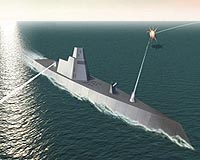| . |  |
. |
711th Human Performance Wing Wright-Patterson AFB OH (AFNS) Feb 10, 2010 A research team from Air Force Research Laboratory's 711th Human Performance Wing recently completed the first-ever documentation of a phenomena imparting key insights into the effects of lasers on biological systems. Led by Dr. Benjamin Rockwell, the Human Effectiveness Directorate-based Ophthalmic Imaging and Laser Damage team recorded the near-infrared-laser-induced occurrence of thermal lensing in a mammalian eye. The results, which will be published in a peer-reviewed publication, will dramatically advance the concepts behind AFRL's "daytime dazzler," a nonlethal option for disrupting adversarial action via disorienting flashes of laser light. For their experiment, the researchers tuned a laser to the wavelength of 1150 nm and then coaxially aligned the device with the beacon laser from an adaptive optics confocal scanning laser ophthalmoscope system. They used the AOcSLO system's integral wavefront sensor to minimize eye aberrations in the imaging path, additionally holding a deformable mirror in the viewing path at this best visible-focus position. The team then delivered a 1 sec laser pulse (exposure) to the eye, using the wavefront sensor to record the thermally induced phase changes provoked in the ocular media by the NIR laser. It was via Small Business Innovation Research Phase II effort that the technology demonstration units leveraged for this Phase III experiment were originally created. Physical Sciences, Inc., one of the technical providers, has since delivered several additional units built upon the platform initially developed for the Air Force. Consequently, installation of this technology has extended into academia (e.g., Indiana University, the University of Texas Medical Branch), as well as to other government labs (e.g., the Food and Drug Administration). While production volume may be lower than in more "typical" Phase III projects, which traditionally receive System Program Office sponsorship, the systems resulting from this Phase III effort nonetheless represent high-dollar (~$200K) installations, generating considerable revenue for the provider and adding significant imaging capabilities for recipient research laboratories.
Share This Article With Planet Earth
Related Links USAF Office of Scientific Research Learn about laser weapon technology at SpaceWar.com
 Maritime Laser Clears Design Hurdles
Maritime Laser Clears Design HurdlesRedondo Beach CA (SPX) Feb 03, 2010 The Maritime Laser Demonstration (MLD) system being developed by Northrop Grumman has passed two milestone reviews by the Office of Naval Research, which point to the real potential of the MLD weapon system design. Representatives from the U.S. Navy, U.S. Army and the High Energy Laser Joint Technology Office conducted a critical design review and critical safety review of the MLD at the D ... read more |
|
| The content herein, unless otherwise known to be public domain, are Copyright 1995-2010 - SpaceDaily. AFP and UPI Wire Stories are copyright Agence France-Presse and United Press International. ESA Portal Reports are copyright European Space Agency. All NASA sourced material is public domain. Additional copyrights may apply in whole or part to other bona fide parties. Advertising does not imply endorsement,agreement or approval of any opinions, statements or information provided by SpaceDaily on any Web page published or hosted by SpaceDaily. Privacy Statement |